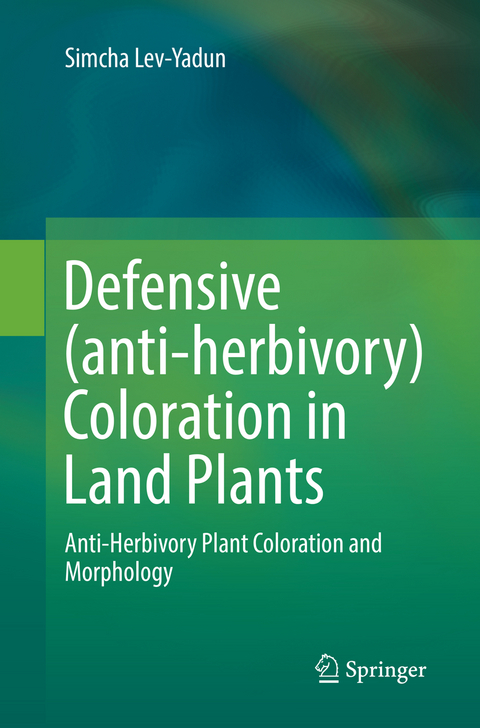
Defensive (anti-herbivory) Coloration in Land Plants
Springer International Publishing (Verlag)
978-3-319-82497-0 (ISBN)
Prof. Simcha Lev-Yadun Department of Biology and Environment,Faculty of Natural Sciences,University of Haifa- Oranim, Tivon 36006 Israel Major Research Interests: The beginning of agriculture: The biology and genetics of plant domestication. The ecology and evolution of defensive vegetative coloration in plants.Developmental processes in plants: meristematic activity and its ecology and regulation, fate of apical meristems, homeosis, pattern formation.Arabidopsis thaliana as a model for the biology of trees.Biology and ecology of trees and other woody plants.Palaeoecology: Dendrochronology, identification of botanical material from archaeological excavations, reconstruction of palaeoenvironments.
1. Introduction.- 2. Plants are not sitting ducks waiting for herbivores to eat them.- 3. The many defensive mechanisms of plants.- 4. No defense is perfect and defense is always relative.- 5. Operating under stress and fear in the military as a lesson concerning difficulties for herbivory in nature. Factors that lower the need for perfect defensive mechanisms including micry. - 6. Evaluating risk: the problematic and even erroneous common view of "no damage or no attack equals no risk".- 7. Partial descriptions of color patterns in floras and handbooks has consequences on the study of plant coloration biology.- 8. Animal color vision.- 9. The nature of signals.- 10. White as a visual signal.- 11. Visual signaling by plants to animals via color.- 12. Müllerian and Batesian mimics are extended phenotypes.- 13. Camouflage.- 14. Seed camouflage.- 15. Pod and seed camouflage in the genus Pisum.- 16. Defensive functions of white coloration in coastal and dune plants.- 17. Gloger's rule in plants: the species and ecosystem levels.- 18. Defensive masquerade by plants.- 19. Potential defense from herbivory by dazzle effects and trickery coloration of variegated leaves.- 20. Plants undermine herbirorous insect camouflage.- 21. Delayed greening.- 22. Red/purple leaf margin coloration: potential defensive functions.- 23. Aposematism.- 24. Olfactory aposematism.- 25. The anecdotal history of discussing plant aposematic coloration.- 26. Aposematic coloration in thorny, spiny and prickly plants.- 27. Fearful symmetry in aposematic spiny plants.- 28. Color changes in old aposematic thorns, spines, and prickles.- 29. Pathogenic bacteria and fungi on thorns, spines and prickles.- 30. Aposematism in plants with silica needles and raphids made of calcium oxalate.- 31. Müllerian and Batesian mimicry rings of aposematic thorny, spiny and toxic plants.- 32. Batesian mimicry and automimicry of aposematic thorns, spines and prickles.- 33. Additional cases of defensive visual Batesian mimicry among plants.- 34. When may green plants be aposematic?.- 35. Spiny east Mediterranean plant species flower later and in a drier season than non-spiny species.- 36. Biochemical evidence of convergent evolution of aposematic coloration in thorny, spiny and prickly plants.- 37. Aposematic coloration in poisonous flowers, fruits and seeds.- 38. Aposematic trichomes: probably an overlooked common phenomenon.- 39. Why is latex usually white and only sometimes yellow, orange or red? Simultaneous visual and chemical plant defense.- 40. Visual defenses basically operating by various mechanisms that have an aposematic component.- 41. Plant aposematism involving fungi.- 42. Do plants use visual and olfactory carrion-based aposematism to deter herbivores?.- 43. Gall aposematism.- 44. Experimental evidence for plant aposematism.- 45. The complicated enigma of red and yellow autumn leaves.- 46. Leaf color variability.- 47. What do red and yellow autumn leaves signal for sure?.- 48. The second generation of hypotheses about colorful autumn leaves.- 49. The shared and separate roles of aposematic (warning) coloration and the co-evolution hypothesis in defending autumn leaves.- 50. Spring versus autumn or young versus old leaf colors: evidence for different selective agents and evolution in various species and floras.- 51. How red is the red autumn leaf herring and did it lose its red color?.- 52. Defensive animal and animal action mimicry by plants.- 53. Caterpillar and other herbivore feeding damage mimicry as defense.- 54. Tunneling damage mimicry.- 55. Butterfly egg mimicry.- 56. Caterpillar mimicry.- 57. Aphid mimicry.- 58. Ant mimicry.- 59. Beetle mimicry.- 60. Spider web mimicry.- 61. Defensive bee and wasp mimicry by orchid flowers.- 62. Gall midge mimicry.- 63. Arthropod wing movement mimicry.- 64. "Eye spot" mimicry.- 65. Snake mimicry.- 66. Visual and olfactory feces and carrion mimicry.- 67. Extended phenotype.- 68. A general perspective of defensive animal mimicry by plants.- 69. Currently temporary final words
| Erscheinungsdatum | 20.02.2019 |
|---|---|
| Zusatzinfo | XXIII, 385 p. 169 illus. in color. |
| Verlagsort | Cham |
| Sprache | englisch |
| Maße | 155 x 235 mm |
| Gewicht | 6204 g |
| Themenwelt | Naturwissenschaften ► Biologie ► Botanik |
| Schlagworte | aposematism • Camouflage • Defense • Entomology • herbivory • leaf color • tree biology |
| ISBN-10 | 3-319-82497-X / 331982497X |
| ISBN-13 | 978-3-319-82497-0 / 9783319824970 |
| Zustand | Neuware |
| Informationen gemäß Produktsicherheitsverordnung (GPSR) | |
| Haben Sie eine Frage zum Produkt? |
aus dem Bereich


